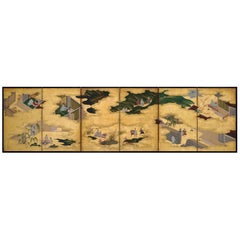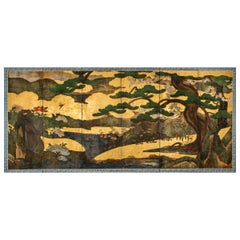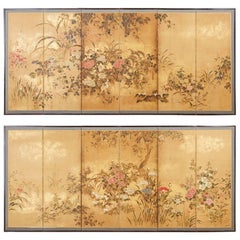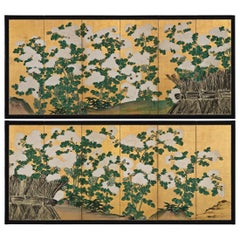Japanese Paintings
51
to
31
1
51
51
51
1
51
133
159
4
82
44
16
14
1
12
4
1
2
6
9
1
Height
to
Width
to
46
29
26
24
23
12,913
1,063
481
202
87
2
1
1
Period: 18th Century and Earlier
Place of Origin: Japanese
Japanese Screen Painting, Circa 1700 'Tales of Ise' by Tosa Mitsusuke
By Tosa Mitsusuke 1
Located in Kyoto, JP
A six-fold Japanese screen by Tosa Mitsusuke (1675-1710), Japan 17th-18th century, Edo period.
The signature reads Shoroku-i ge Tosa sa Konoe Shogen Mit...
Category
Late 17th Century Edo Antique Japanese Paintings
Materials
Gold Leaf
Japanese Six-Panel Screen Garden Landscape by River's Edge
Located in Hudson, NY
Kano School painting showing ancient pine, exotic birds, peonies, azalea and cherry tree in bloom on far right. Early Edo period painting, (1614 -...
Category
Late 17th Century Edo Antique Japanese Paintings
Materials
Gold Leaf
Pair of Japanese Edo Rimpa School Screens after Tawaraya Sotatsu
Located in Rio Vista, CA
Impressive pair of 17th century Japanese Edo period Rinpa school screens made in the manner and style of Autumn Grasses by Tawaraya Sotatsu (1570-1640). Beautifully decorated with wi...
Category
17th Century Edo Antique Japanese Paintings
Materials
Gold Leaf
Mid-18th Century Japanese Screen Pair, One Hundred Flowers, Chrysanthemums
Located in Kyoto, JP
Omori Soun (b. 1704)
Chrysanthemums - One Hundred Flowers
A Pair of Six-fold Japanese Screens. Ink, color, gofun and gold leaf on paper.
Dating ...
Category
Mid-18th Century Edo Antique Japanese Paintings
Materials
Gold Leaf
Japanese Two Panel Screen, Chrysanthemums
Located in Hudson, NY
Beautiful white chrysanthemums are emphasized by heavy gold on a soft floral landscape, while gold clouds create a striking and dream-like floral scene. Gold leaf and gofun with min...
Category
Early 18th Century Antique Japanese Paintings
Materials
Gold, Gold Leaf
17th Century Japanese Screen. Ink Plum Tree & Birds by Kano Naonobu.
Located in Kyoto, JP
Kano Naonobu (1607-1650)
Plum Tree and Birds
Six-fold Japanese Screen. Ink and slight color on paper.
In this evocative ink work spread over a six-panel folding screen, we see the consummation of the elegance and refinement of the Edo Kano school. This 17th century screen is a rare surviving example of a large-scale bird and flower painting by Kano Naonobu, the younger brother of Kano Tanyu...
Category
17th Century Edo Antique Japanese Paintings
Materials
Wood, Paper
Japanese Two-Panel Screen: Cranes on Gold
Located in Hudson, NY
Early Kano School painting of pine trees overlooking two beautifully painted cranes and floral design in a natural setting by water’s edge. Mineral pig...
Category
Late 18th Century Antique Japanese Paintings
Materials
Gold, Gold Leaf
Set of Eight Antique Japanese Bird Paintings
Located in Palm Beach, FL
Rare and remarkable set of eight 18th century paintings of birds on silk executed with egg tempera in a delicate yet colorful style. Interesting historica...
Category
18th Century George III Antique Japanese Paintings
Materials
Silk, Paint
17th Century Japanese Screen Pair. Tiger & Dragon by Kaiho Yusetsu
Located in Kyoto, JP
Kaiho Yusetsu (1598-1677)
Tiger and Dragon
Early Edo Period, Circa 1650
A Pair of Six-fold Japanese Screens. Ink and slight color on paper.
Dimensions:
Each screen: H. 171 cm x W. 380 cm (67.5’’ x 149.5’’)
In this pair of early Edo period Japanese screens a group of tigers prowl in a bamboo grove whipped with fierce wind, while a dragon claws through clouds and mist. The dragon embodies elemental qualities - looming out of the mist, the coils of its body disappearing in the clouds. The dragon is calling for rain, symbolizing spring which is considered the fountain of life. On the other side, the tigers calls for the wind, symbolizing autumn which is considered the end of life. Tigers were familiar motifs within Japanese art from ancient times though the animals were imaginary to the people in the 17th century. While dragons and tigers are usually associated as sacred and ferocious, in this painting, both animals have rather amusing expressions. The tigers appear to glare at the dragon with cat-like eyes, and the look on the swirling dragon’s face appears almost affectionate - lending a playful flair to an otherwise magnificent theme.
The tiger and dragon are cosmological symbols of the balancing forces in the world. Screens such as this were originally meant to express the fluctuating nature of the world. For Japanese in the early Edo period, they likely suggested the powers of the cosmos. In Japan the tiger and dragon motif was originally absorbed into the circles of Zen monasteries before spreading into the secular world. The theme especially appealed to the military classes with the Kano school, the official painters to the Shogun and the samurai, being the leading contributors. The painter of this pair of screens, Kaiho Yusetsu (1598-1677), was closely patronized by the third Shogun Tokugawa Iemitsu. In his later years he worked with Kano school artists...
Category
Mid-17th Century Edo Antique Japanese Paintings
Materials
Silk, Wood, Paper
260 Year Old Japanese Hanging Scroll with Painting of the 9-Headed Dragon Deity
Located in Amsterdam, NL
Amazing 260 year old Japanese kakejiku (hanging scroll) with a refined painting of the nine headed dragon deity, with a Buddhist flame as a crown, an...
Category
Mid-18th Century Antique Japanese Paintings
Materials
Metal
17th Century Japanese Screen Pair, Cranes
Located in Kyoto, JP
Cranes
Anonymous, Kano School.
Edo period, second half of the 17th century.
Pair of six-panel screens. Ink, pigment gofun and gold l...
Category
1670s Edo Antique Japanese Paintings
Materials
Gold Leaf
Japanese Six Panel Screen: Tosa School Painting of Theatre Scene
Located in Hudson, NY
with thought to be Izumo no Okuni (1578-1613). Mineral pigments and gold dust on mulberry paper with silk brocade border.
Category
18th Century Antique Japanese Paintings
Materials
Gold
17th Century Japanese Framed Panel by Kano Sansetsu, White Herons in Snow
Located in Kyoto, JP
Kano Sansetsu (1589-1651)
White herons in snow
Edo period, circa 1640
Framed painting. Ink on paper.
Kano Sansetsu is a Japanese painter who ...
Category
17th Century Edo Antique Japanese Paintings
Materials
Paper
Japanese Six Panel Screen: Scenes in and Around Kyoto, 'Rakuchu Rakugai-Zu'
Located in Hudson, NY
The left two panels is the intersection of the Tokaido (an important and historical road that connects Kyoto with Tokyo) at Sanjo (Sanjo translates to "Third Street" and is the main ...
Category
18th Century Antique Japanese Paintings
Materials
Gold Leaf
Japanese Painting, 17th Century, Tale of Genji, Tosa School
Located in Kyoto, JP
Illustration to an unidentified chapter of the Tale of Genji (Genji Monogatari)
Tosa School (second half of the 17th Century)
Ink, pigment, gofun and...
Category
Late 17th Century Edo Antique Japanese Paintings
Materials
Gold Leaf
Japanese Six Panel Screen Scattered Fans
Located in Hudson, NY
Striking painting depicting scattered fans painted on gold leaf. Featuring various scenes from classic Japanese literature, flowers and birds. Mineral pigmen...
Category
Mid-18th Century Antique Japanese Paintings
Materials
Gold Leaf
Japanese Six Panel Screen by Garden’s Edge
Located in Hudson, NY
Edo period (18th century) painting of a flowing array of various types of chrysanthemums painted on beautifully faceted heavy gold leaf and behind afinely painted fence. Petals of th...
Category
18th Century Antique Japanese Paintings
Materials
Gold
Japanese Screen Painting, circa 1700 'Horses' by Kano Tanshin
Located in Kyoto, JP
Horses
Kano Tanshin Morimasa (1653-1718)
Two-panel tea-ceremony Japanese screen or furosaki
Ink on gold leaf,
late 17th-early 18th century
Measures: H 55 cm x W 182 cm
The Kano school was closely aligned with the warrior class in Japan. The samurai, who lived in a closed and rigid hierarchical society established by the Shogunate, were drawn to the energy and freedom horses symbolize; Kano school artists commonly depicted the equine creatures as they are here, in unfettered and carefree family groups. China originally introduced horse paintings to Japan; the works typically focused on capturing the essence of horses in their various environments and often involved integrating human figures into the images.
Kano Tanshin Morimasa (1653-1718) was the son of Kano Tanyu...
Category
1690s Edo Antique Japanese Paintings
Materials
Gold Leaf
Japanese Six Panel Screen: Courtiers Festival
Located in Hudson, NY
Courtiers are those that are in attendance at a royal court. Beautifuly painted court figures in procession with ancient musical instruments. Tosa School painting in mineral pigments...
Category
Late 18th Century Antique Japanese Paintings
Materials
Gold Leaf
18th Century Japanese Floral Paintings, Set of 5, Mineral Pigments on Gold Leaf
Located in Kyoto, JP
A set of 5 Japanese floral paintings from the 18th century. Each painted with mineral pigments directly applied to gold leaf. They were originally designed to be mounted on the leave...
Category
Mid-18th Century Edo Antique Japanese Paintings
Materials
Gold Leaf
Japanese Six Panel Screen Spring into Summer
Located in Hudson, NY
Mid-Edo period, 18th century painting with gold leaf and mineral pigments. A summer landscape depicting summer flowers and exotic birds, accented with an abstract cloud design. Miner...
Category
18th Century Edo Antique Japanese Paintings
Materials
Gold Leaf
Japanese Six Panel Screen Battle of Yashima from the Heike Monogatari
Located in Hudson, NY
Yamato-e painting depicting a great land and sea battle, the Battle of Yashima, March 22, 1185. The Heike were flushed from the mountainous and prote...
Category
18th Century Antique Japanese Paintings
Materials
Gold
Japanese Two Panel Screen Pine and Red Sun on Gold
Located in Hudson, NY
Mineral pigments on gold leaf. Signature and seal read: Anei H-eishin Boshun ga, dated: late spring 1766 with a dedication to Okyo (Maruyama).
Category
Mid-18th Century Antique Japanese Paintings
Materials
Gold Leaf
Japanese Six Panel Screen: Rimpa Painting of Autumn Flowers and Grasses on Gold
Located in Hudson, NY
Rimpa School. Ink, colors and gold on mulberry paper with a silk brocade border and black trim.
Category
Early 18th Century Antique Japanese Paintings
Materials
Paper
Japanese Two Panel Screen Suiboku Landscape in Sesshu Style
Located in Hudson, NY
Suiboku is a style of ink painting that is reminicent of the way calligraphers paint. Masterfully painted Muromachi Period (1336-1573) painting, unique in style and strength for the period with very bold lines. Sesshu Toyo...
Category
16th Century Antique Japanese Paintings
Materials
Silk, Paper
Japanese Two Panel Screen Bamboo in Early Snow
Located in Hudson, NY
Kano School painting, of the edge of a bamboo grove in early winter snow with very fine gold mist. Mineral pigments and gold dust on mulberry paper with 18th century brocade.
Category
18th Century Antique Japanese Paintings
Materials
Paper
Japanese Six Panel Screen: Karako 'Chinese Children'
Located in Hudson, NY
Children at play in a Chinese palace garden, a favorite subject of Japanese painters. Kano School painting in mineral pigments on mulberry paper with si...
Category
18th Century Antique Japanese Paintings
Materials
Bronze
Japanese Two Panel Screen: Gibbons in a Tree
Located in Hudson, NY
Ink painting on mulberry paper of gibbons in a tree with hints of gold in the sky.
Category
Early 18th Century Antique Japanese Paintings
Materials
Paper
17th Century Japanese Screen Pair by Soga Nichokuan, Hawks on Pine & Plum Trees
Located in Kyoto, JP
Hawks on plum and pine
Soga Nichokuan (active circa 1625-1660)
Pair of six-fold screens.
Ink, mineral pigments, gofun, gold and speckled gold leaf on paper.
Upper seal: H...
Category
1640s Edo Antique Japanese Paintings
Materials
Wood, Paper
Circa 1700 Japanese Screen Pair, Cranes & Pines, Kyoto Kano School
Located in Kyoto, JP
Pines and Cranes
Anonymous. Kyoto Kano School.
Late 17th/early 18th centuries, circa 1700.
Pair of six-panel Japanese folding screens.
Ink, gofun, pigment and gold leaf on paper.
This bold composition presents two pine trees extending to the left and right across a gold leaf background. One tree is silhouetted against a green ground, golden clouds obscuring its true size, the other stretches across a stylized waterway. The pines are paired with Manchurian cranes with red crests and snow white plumage. Both have been highly auspicious motifs in East Asia since Chinese antiquity. Here the artist utilized fluid and instinctive ink brushstrokes to define the trunk, branches and tail feathers, in strong contrast to the precision and sharp angularity of the crane’s legs and beaks. The adoption of this vast metallic painting support required an unerring sense of design and composition, so that the negative space surrounding motifs could imply context for the otherwise floating pictorial elements. The brushwork detailing the trunks of the pines, the exaggerated dimensions of the pine trees and the strength and dynamism of the composition are all reminiscent of Kano Eitoku...
Category
Late 17th Century Edo Antique Japanese Paintings
Materials
Gold Leaf
Japanese Six-Panel Screen Waterfall and Cherry in Audubon Landscape
Located in Hudson, NY
Japanese six-panel screen: waterfall and cherry in Audubon landscape, Edo period painting, 18th century, depicting summer and spring. A Kano Schoo...
Category
Mid-18th Century Edo Antique Japanese Paintings
Materials
Gold Leaf
Japanese Six-Panel Screen Women of the Court in the Garden
Located in Hudson, NY
Japanese six-panel screen: Women of the Court in the Garden. Edo period (circa 1700) painting of an early Kano school subject matter: nobility socializing in a coutryard garden. Deta...
Category
Early 1700s Edo Antique Japanese Paintings
Materials
Gold Leaf
Japanese Two-Panel Screen Ink Painting of Palm Trees on Paper
Located in Hudson, NY
Japanese two-panel screen: ink painting of Palm Trees on paper, Edo period (1787) beautiful painting of Japanese windmill palm trees. Ink paint...
Category
18th Century Edo Antique Japanese Paintings
Materials
Paper, Silk, Wood
17th Century Japanese Framed Painting by Kano Sansetsu, Plum Blossoms in Snow
Located in Kyoto, JP
Kano Sansetsu (1589-1651)
Plum blossoms in snow
Edo period, circa 1640
Framed painting. Ink on paper.
Kano Sansetsu is a Japanese painter who...
Category
17th Century Edo Antique Japanese Paintings
Materials
Paper
18th Century Japanese Two-Panel Screen Collection of Fans on Gold
Located in Hudson, NY
18th century Japanese Screen of a Collection of Fans. Paintings on fans depict famous Japanese painting subjects, this screen was most li...
Category
18th Century Edo Antique Japanese Paintings
Materials
Gold Leaf
Japanese Two Panel Screen Ink Painting of Banana Leaves on Mulberry Paper
Located in Hudson, NY
Edo period (dated 1787) beautiful painting of unfurling palm leaves with romping puppies in the background. Ink painting (sumi-e) on mulberry paper. Signature reads: Okyo. Calligraph...
Category
Late 18th Century Edo Antique Japanese Paintings
Materials
Paper
Japanese Edo Festival Screen, c. 1750
Located in Chicago, IL
This 18th century folding screen is a stunning example of Japanese artistry. Beautifully painted with delicate brushwork, the evocative screen depicts a lively festival during the Ed...
Category
Mid-18th Century Edo Antique Japanese Paintings
Materials
Paper
Pair of Japanese Ink Hanging Scrolls Kano Tanyu
By Kano Tan'yu 1
Located in Atlanta, GA
A fine matching pair of hanging scrolls ink on paper mounted in green brocade borders circa Edo period (17-18th century). The Kano school painting depicts wild geese in the reeds by the margin of water, a popular subject borrowed from the Chinese tradition. Both painting were signed as Tanyu with a red seal of Morinobu, his birth name. The storage box is also present and was inscribed with the title Painting of Geese and Reeds and Kano Tanyu...
Category
Late 17th Century Japonisme Antique Japanese Paintings
Materials
Wood, Paper
17th Century Japanese Two-Panel Screen, Gibbons of Folklore
Located in Hudson, NY
Japanese two-panel screen: Gibbons of Folklore, Edo period (17th century) Kano School painting of gibbons in Japanese fables. The left panel represents a Japanese fable of a monkey a...
Category
Late 17th Century Edo Antique Japanese Paintings
Materials
Silk, Wood, Paper
Late 17th-Early 18th Century Japanese Six-Panel Screen, Battle at Uji Bridge
Located in Hudson, NY
Japanese six-panel screen: Battle at Uji Bridge, the first battle at Uji was in 1180 and it marked the start of the Heike Wars. The Genji troops crossed the...
Category
Late 17th Century Edo Antique Japanese Paintings
Materials
Gold Leaf
18th Century Japanese Scroll of Poppies
Located in Hudson, NY
18th century Japanese scroll of poppies. Edo Period (early 18th century) Japanese painting of poppies with lilies in the background. Seal on the lower...
Category
Early 18th Century Edo Antique Japanese Paintings
Materials
Silk, Paper
18th Century Japanese Kano School Landscape Screen
Located in Prahran, Victoria
Japanese Kano school screen with pine tree, camellias, cherry blossom and Chinese figures in the landscape, circa 18th century.
Materials: Pigmen...
Category
18th Century Antique Japanese Paintings
Materials
Silver Leaf
Japanese Painting, 17th Century, Tale of Genji, Makibashira, Tosa School
Located in Kyoto, JP
The Handsome Pillar (Makibashira), Illustration to Chapter 31 of the Tale of Genji (Genji Monogatari)
Tosa School (second half of the 17th Century)
I...
Category
Late 17th Century Edo Antique Japanese Paintings
Materials
Gold Leaf
Large Antique Zen Japanese Ink Scroll After Sesson Shukei
Located in Atlanta, GA
A Japanese Sumi ink painting with light color wash mounted with brocade borders as a hanging scroll (Kakejiku). The painting depicts the famously eccentric Buddhist monks Hanshan and Shide (known in Japan as Kanzan and Jittoku). Often as a pair, they have been a popular motif in Japanese Zen painting...
Category
18th Century Japonisme Antique Japanese Paintings
Materials
Silk, Paper
Japanese Painting, 17th Century, Tale of Genji, Fujibakama, Tosa School
Located in Kyoto, JP
Purple Trousers (Fujibakama), Illustration to Chapter 30 of the Tale of Genji (Genji Monogatari)
Tosa School (second half of the 17th century)
Ink, ...
Category
Late 17th Century Edo Antique Japanese Paintings
Materials
Gold Leaf
Pair of Antique Japanese Paintings of Karashishi, Edo Period, 18th Century
Located in Prahran, Victoria
A rare pair of antique Japanese Karashishi paintings in a landscape of rocks and peony flowers on gold leaf ground in fine handmade frames, Edo period, early 18th century. The Karash...
Category
Early 18th Century Edo Antique Japanese Paintings
Materials
Gold Leaf
Antique Japanese Hanging Scroll Attributed to Iwasa Matabei
Located in Atlanta, GA
An antique ink and color on paper hanging scroll (kakejiku) with brocade border. It appears to be a fragment of a larger hand scroll depicting a procession of a lord with his entoura...
Category
Early 17th Century Japonisme Antique Japanese Paintings
Materials
Silk, Paper
17th century Japanese Falcon Painting, Mitani Toshuku, Unkoku School
By Mitani Toshuku
Located in Kyoto, JP
Mitani Toshuku (1577-1654)
“Falcon”
Wall panel, ink and light color on paper.
Upper Seal: Mitani
Lower Seal: Toshuku
Dimensions:
Each 118.5 cm x 51 cm x 2 cm (46.5” x 20” x .75”)
Individual falcon paintings by Mitani Toshuku (1577-1654), an early artist of the Unkoku School. Founded by Unkoku Togan (1547–1618), a master of the Momoyama period, the Unkoku school enjoyed long lasting patronage in southern Japan. Togan was a retainer of the Mori family in present day Yamaguchi prefecture. Members of the school considered themselves to be in the artistic lineage of Sesshu Toyo...
Category
Early 17th Century Edo Antique Japanese Paintings
Materials
Paper
Japanese Painting, Framed Panel, 17th Century Falcon by Mitani Toshuku
By Mitani Toshuku
Located in Kyoto, JP
Mitani Toshuku (1577-1654)
“Falcon”
Wall panel, ink and light color on paper.
Upper seal: Mitani
Lower seal: Toshuku
Dimensions:
Each 118.5 cm x 51 cm x 2 cm (46.5” x 20” x .75”)
Individual falcon paintings by Mitani Toshuku (1577-1654), an early artist of the Unkoku School. Founded by Unkoku Togan (1547–1618), a master of the Momoyama period, the Unkoku school enjoyed long lasting patronage in southern Japan. Togan was a retainer of the Mori family in present day Yamaguchi prefecture. Members of the school considered themselves to be in the artistic lineage of Sesshu Toyo...
Category
Early 17th Century Edo Antique Japanese Paintings
Materials
Wood, Paper
Pair of Antique Japanese Flower Paintings by Yanagisawa Kien, circa 18th Century
By Yanagisawa Kien
Located in Prahran, Victoria
Pair of antique Japanese Nagasaki School paintings by Yanagisawa Kien (1704-1758), depicting classical ikebana flower arrangements. Each painted on silk in mineral pigments and beari...
Category
Mid-18th Century Edo Antique Japanese Paintings
Materials
Silk
Japanese Six Panel Screen, Morning Glories on a Bamboo Arbor
Located in Hudson, NY
Very early painting of a gold arbor with morning glories, the mulberry paper almost appears polished. Please see close-up photos to show staining from use over the many years (on the...
Category
Early 17th Century Antique Japanese Paintings
Materials
Paper
Recently Viewed
View AllMore Ways To Browse
Long Buffet Vintage
Italian Dresser Brass
Modern Marble Console Base
Louis Xv Bureau Plat
Small Antique China Cabinet
Small Antique Chinese Cabinet
Small China Cabinet Antique
Console Table With Lions
Used Kitchen Cabinets And Counters
Antique Small China Cabinet
Antique Chinese Small Cabinet
Pair Of Swedish Commodes
Narrow Depth Storage
Store Display Case Wood
Traditional Wood Console Table
Matching Walnut Dressers
Sculptural Chest Of Drawers
Thick Glass Top Console Table





